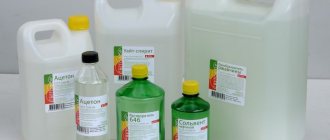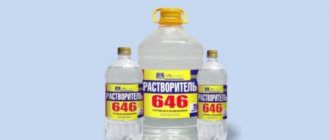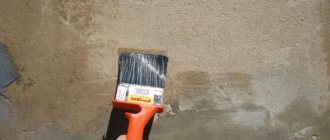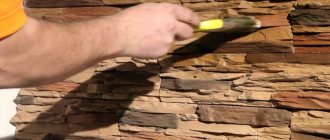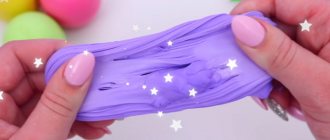The areas of application of solvents and thinners are extensive. When performing repair work, we inevitably deal with solvents for varnish, enamel, and paints. Solvents of rust, concrete, liquid glass, liquid nails, polyurethane foam and other materials are used in construction. Artists constantly use solvents, and in everyday life they help us remove complex contaminants. Our article will help you understand this big topic so that you can quickly answer the question: which solvent is best to use in each specific case.
Features and Specifications
Solvents are rapidly evaporating organic mixtures capable of dissolving thick substances, forming a solution of homogeneous composition.
The main purpose of the organic mixture is to dilute varnishes and paints to the desired thickness before applying to the surface to be painted.
The following requirements apply to solvents:
- Lack of reaction after applying paint to the surface;
- They should not lose hygroscopicity, that is, interaction with water should not lead to a loss of quality characteristics;
- The process of adding solvent to paint is recommended to be done without much effort, ensuring a homogeneous mixture is obtained.
The influence of the solvent on the paint occurs at the very beginning of its application to the surface to be painted. After a short period of time, it evaporates.
Each type of paint requires a certain category of solvent. With the right choice of chemical, the paint becomes uniform and easy to apply.
There are organic and inorganic types of solvents:
Organic types are divided into:
- Easily evaporated;
- Medium-volatile;
- Solidly volatile.
Easily evaporated substances include gasoline, solvent, and white spirit. They are used for diluting oil or acrylic paints, varnishes and enamels to a certain thickness.
- The listed solvents are flammable materials. It is recommended to carry out painting work away from fire.
- Kerosene is a medium-volatile substance. It is often added to dilute oil- or acrylic-based paints.
- A representative of a low-volatile soluble substance is turpentine. It has a specific smell and high density.
- The mixture can also be used to bring varnishes, some types of enamels and oil-based paints to a uniform consistency.
A significant disadvantage of organic mixtures is the strong suffocating odor. Therefore, you must wear a respirator to avoid poisoning.
There are paints that can be diluted with water. But this method is not suitable in regions with harsh weather conditions. At low temperatures, such coatings begin to crack.
Thinner for oil paints. Which to choose?
Oil paint thinner plays one of the most important functions in painting. You've probably seen many types of thinners in art stores and wondered which one is best? There are different thinners and have different functions and properties.
Your choice depends entirely on what and in what manner you will draw.
Do you need the paint to dry faster or longer, should the paint layer be shiny or matte, is rich color important to you, or do you want a muted look to the painting?
A little theory
Actually, there are several substances that dilute oil paints: turpentine, white spirit, pinene, varnish, oil. By the way, they can not only dilute paints, but also clean and wash brushes and palettes after painting.
Thinners white spirit, pinene and turpentine in their pure form are capable of very rapid evaporation and, therefore, rapid drying. At the same time, they do not give such shine and saturation to paints after drying as oil or varnish. It is also worth noting that after them the painting may appear dull and dull.
Solvent composition information
Painters use:
- White Spirit;
- Solvent;
- Petrol;
- Benzene;
- Ethanol;
- Turpentine.
Ethylene is the main component in the production of solvents. It is an oily liquid with a specific odor. In the production of ethyl alcohol, the procedure of hydration of ethylene with concentrated sulfuric acid is used. Ethyl alcohol has a toxic effect on human health; prolonged contact with the substance can cause poisoning.
Turpentine is a solvent that is widely used in repairs and construction. Turpentine is obtained from pine resin. It has a yellowish tint, the smell of pine oils, and is poorly soluble in water.
Turpentine is a highly flammable liquid. When storing containers with this type of solvent, smoking is strictly prohibited, and the room must have good ventilation.
- White spirit is a high-boiling fraction of liquid carbons. It is used to dilute materials containing bitumen fractions. Technical characteristics of the solvent - this is a colorless solution with the smell of kerosene, used to impart the required density and density to paints, drying oils and some types of putties and primers. The chemical degreases surfaces and removes paint from tools.
- Solvent is a transparent substance with a strong odor, used as a solvent for paints. It is a mixture of aromatic carbons obtained from petroleum products. Belongs to category No. 1 flammable substances.
- Petroleum benzene has a pungent odor. The quality scale of a chemical product includes several categories. May ignite at temperatures of 500 degrees. It is not able to dissolve in water and glycerin solution.
- Organic solvents are classified as highly toxic materials and may adversely affect health. It is important to wear special clothing and a respirator when working.
Toxic substances are stored in warehouses equipped with racks on which containers are placed with the cap facing up.
Lucky
In oil painting, varnishes are divided according to their type of application: painting varnishes and topcoat varnishes. Some are universal in use. Separately, it is worth highlighting varnishes for retouching. You can read more about varnishing a work in the article “Varnishing oil painting.”
Varnishes for painting
They are used as an additive for artistic oil paints and are presented in the form of a solution of resin in pinene (art turpentine).
Dammar varnish is thick, used as an additive to paints and as a topcoat. It is warm in color and turns yellow over the years.
It is very important! Therefore, they need to cover only warm-colored works. Over time, it will add nobility to the painting
Dammar varnish can be diluted with a small amount of pinene. If you add pinene to the varnish one to one, the varnish will be matte, and you get an interesting effect.
Mastic varnish - can serve not only as an additive to paints, but also as a wiper for intermediate layers in multi-layer painting, replacing retouch varnish in this. It is also used as a topcoat varnish. It tends to turn a little yellow over time, more than dammar. Gives the work a glossy finish. Very elastic.
Copal varnish is dark in color and is used as an additive to paints. The dried film of copal varnish is insoluble in organic solvents. Therefore it is considered the strongest among painting varnishes.
Topcoat varnishes
Designed to cover oil paintings in order to protect them from sun damage and sun rays, as well as to add richness and shine to the paint layer.
Acrylic-pistachio varnish (analogous to acrylic-styrene) - its film is almost colorless, has great elasticity and is stronger than the films of mastic and dammar varnishes. They should cover works in cool colors.
Pistachio varnish - its film is almost colorless and very elastic. True takes longer to dry than other topcoat varnishes.
Retouch varnish - used to prevent fading during multi-layer oil painting, as well as to enhance the adhesion of paint layers. It is applied before starting work on the desired area. This varnish slightly dissolves the top layer of paint, thereby enhancing adhesion to the new layer. The varnish also helps remove dull, faded areas, restoring the brightness of the color. According to the advice of old masters, instead of retouching varnish, you can use a cut from a head of garlic.
All about OIL PAINTING TECHNIQUES
Types of solvents
Organic solvents are divided into three main subgroups:
- Carbon substances.
- Alcohol-based substances.
- Ester types of chemical solvents.
Carbon substances
White spirit surpasses other chemicals in demand and popularity. Despite the weak solvent properties, the relative harmlessness and reasonable cost, the solvent is widely used for diluting paints, nitro enamels and varnishes.
- Petroleum benzene is not a water-soluble substance.
- It has a pungent odor and goes well with carbon compounds.
- When working with this highly volatile substance, it is recommended to wear a respirator, since petroleum benzene can emit toxic fumes.
Turpentine is used to dilute putty and oil-based paints.
How to dilute artistic oil paints for painting
Oil painting is one of the most interesting and popular types of fine art. To create paintings, paints based on vegetable oils are used.
Oil paint for painting is a mixture of color pigment and vegetable oil, usually linseed. Of course, if you want to create a relief on canvas, you don’t have to use thinners at all. But even in this case, sometimes it is necessary to dilute the paint to a softer consistency.
Alcohol based solvents
Methanol is a colorless, odorless substance. When combined with water it creates a homogeneous liquid. Methyl alcohol belongs to the category of highly toxic substances.
- Ethyl alcohol has a pungent odor and is highly flammable.
- Adding butyl alcohol to nitro paint promotes the formation of a smooth structure of the painted surface.
- Ethylene glycol is a substance with a thick, odorless consistency.
Works effectively with nitro enamels. Surfaces painted with paints and varnishes containing ethylene glycol are shiny and smooth.
Do no harm!
Most traditional domestic solvents are extremely reactive products. Take, for example, the well-known solvent 646 (from a physicochemical point of view, this is precisely a solvent). This is a complex product that includes more than seven components (toluene, ethanol, butyl acetate, butanol, ethylcellosol, acetone, etc.). Such an aggressive composition allows you to effectively dissolve many organic substances, which is what made this solvent so popular.
But what happens if you add this solvent to, say, acrylic enamel or varnish? Or a base?
As already mentioned, the paint and varnish manufacturer selects certain solvents for its products not anyhow, but taking into account the speed and uniformity of evaporation. And the components present in cheap solvents do not contribute to normal evaporation, rather the opposite.
Thus, acetone, which is part of the 646th solvent, is too volatile and does not ensure optimal drying of the film during evaporation. It evaporates too quickly, which leads to the immediate formation of a surface film that prevents the release of residual solvents from the depths of the layer. The result is the familiar boiling, as well as a decrease in gloss and low coating hardness.
Alcohols that are part of domestic solvents also have an extremely negative effect on the film formation process of acrylic paints and varnishes. As you know, alcohols contain water, and water interferes with the normal polymerization of acrylic materials, “interfering” with the reaction, causing it to proceed incorrectly. As a result, instead of a durable polymer film, we get a “loose” coating that is susceptible to shrinkage and has a low gloss.
It should also be remembered that solvent 646 is aggressive towards many types of plastic.
If we talk about adding non-recommended liquids to base enamels, this can cause “apple-coloring” and stripes of different colors. And be prepared for the fact that these defects can only appear after varnishing and the painted surface has completely dried. There have been cases when “clouds” appeared several hours before the car was delivered to the client. Pleasant, as they say, is not enough.
It has also been noted that the aggressive components of domestic solvents “burn” some particularly sensitive pigments in the composition of enamels. This distorts the color of the paint, which is especially noticeable on light colors. For example, white enamel acquires a beige tint after adding solvent. This color in itself may be beautiful, but for some reason the car owner objects...
Representatives of ester solvent types
These include:
- Methyl acetate type of solvent is a quickly evaporating substance.
- Ethyl acetate is characterized by a pleasant odor, rapid volatility and low boiling rate. The solvent has a yellowish tint, rapid volatility and is therefore used when increasing the time interval for complete drying of paints and varnishes.
- Amyl acetates have similar characteristics to butyl acetate, have a distinctive odor, and evaporate slowly.
- Acetone is one of the most toxic types of solvents with a heavy odor, high volatility and flammability.
- A mixture of soluble substances is used to dilute nitro enamels to the desired thickness. They contain esters of complex structure. The quality of the painted layer is affected by the composition of the solvent. In particular, if you add more chemicals to the paint than necessary, the coating will become cloudy. By adding a substance with long volatility, the painted layer will become smooth and attractive in appearance.
- Acrylic solvent is similar to a white liquid with a specific odor, is made on the basis of acrylic and is produced in several versions. Their use largely depends on the type of surfaces being painted, weather conditions and other factors.
- Glue solvent. Sometimes it is necessary to dilute the glue to a more liquid consistency or completely remove it from the surfaces. Some of the best are xylene, acetone or mixtures based on ethyl acetate.
Use in everyday life
The industrial applications of solvents are extremely diverse. You cannot do without them when synthesizing polymers, extracting useful components from reaction mixtures, and many other technological processes. Even the purification of food products (for example, vegetable oils) often occurs by extraction from solution. But in a home or small workshop, the use of a solvent is required only in a few cases. Among them, two main ones can be distinguished.
Degreasing surfaces. It is often necessary to clean parts or objects from grease stains, dried traces and other contaminants that cannot be washed off with water. The reason is clear - oils and fats are insoluble in water, even if detergent is added to it. In these cases, it is enough to wipe the dirty item with a rag soaked in solvent to solve the problem. The same method is used to prepare wooden or metal objects before coating or painting.
Painting works. Paints and varnishes (enamels, paints, varnishes) are the most common example of liquid synthetic polymers that can be found in everyday life. The solvent is necessarily present in the paint itself, so it will be needed to dilute the thickened material to a working state.
With the help of an active solvent and long stirring, you can even restore the characteristics of partially dried paint. You can also rinse the tool after use, remove accidental drops, and clean clothes if you use a solvent. An important quality of paint that directly affects the result is its viscosity, which determines how well the material spreads over the surface and is held on a brush or roller. With the pneumatic painting method (spray gun), the viscosity indicator should be within fairly narrow limits, which is also achieved by dilution.
Numbered solvent grades
Consumers are offered a wide range of solvent mixtures to choose from, which can be difficult for an inexperienced person to understand. For convenience, the manufacturers decided to number them.
The most famous brands are:
- R-4 is a universal solvent containing toluene and acetone. This chemical is added to alkyd paints and emulsions based on chlorinated polymers. The paint diluted with solvent R-4 becomes homogeneous, and upon completion of painting work a protective film is created on the surface.
- 646 is a solvent that is a yellow substance. It is characterized by easy volatility and a specific odor. The composition includes aromatic hydrocarbons and alcohols. It is distinguished by its versatility and good quality characteristics. Use caution when using solvent. When it gets on the surface to be painted, it instantly dissolves it. Once added to paint, the painted surface becomes smooth and shiny. The specific smell of the substance disappears after it evaporates.
- RS - 2 is characterized by a lot of positive qualities. This is a clear, quickly evaporating liquid containing xynol and white spirit. The substance is used for diluting paints and varnishes, bitumen substances. Characteristic properties of the solvent - with prolonged contact it can cause severe headaches and nausea.
After reading the introductory information about solvents, we can conclude that each of them copes well with the task. When working at home, windows should be open to avoid intoxication of the body.
Car enamels from the manufacturer Vika
Quite often, car owners are faced with the problem of updating their car’s paintwork; this is caused by the negative influence of the external environment on the car’s coating. Automotive enamels are used to perform painting work.
The Vika brand represents a wide range of materials for the repair and restoration of bodywork. The Vika line of paints and varnishes contains acrylic and alkyd enamels used for painting vehicles. Not long ago, the company launched a new generation of material on the market - 2K acrylic-urethane enamel AK-1305. This vika enamel is produced in fourteen colors. Its difference from its predecessors lies in its increased viscosity and the time required for drying. In addition, the new generation of coatings is distinguished by gloss. Its presence eliminates the need to apply additional varnish.
The Vika brand represents a wide range of materials for the repair and restoration of bodywork.
Technical characteristics and scope
Vika auto enamel, sold at a very reasonable price, has the following parameters:
- Drying and processing modes;
- After painting is completed, the paintwork dries in 30 minutes. with uniform heating to 80 degrees, in 45 minutes. - at 60 degrees. and in 60 hours. at 20 degrees;
- Polishing the painted surface can only be done after 24 hours; the outside temperature should be in the range of 20 degrees.
Polishing the painted surface can only be done after 24 hours.
